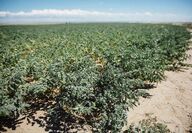Sorted by date Results 1 - 10 of 10

BOZEMAN – Two graduate students in Montana State University’s College of Agriculture have published new research on two aspects of management for one of the region’s most damaging agricultural pests. Wheat stem sawflies cost agricultural producers millions of dollars in losses each year, according to the Montana Wheat and Barley Committee. Surveys conducted by the National Agricultural Statistics Service found that nearly a quarter of respondents in Montana had lost up to 10% of their yield...

BOZEMAN – A large collaborative project exploring a new oilseed crop led by scientists in Montana State University's College of Agriculture was featured last month by the U.S. Department of Energy for its high scientific impact. The DOE featured work spearheaded by Chaofu Lu in MSU's Department of Plant Sciences and Plant Pathology in its Science Highlights series, which features research the DOE identifies as particularly exciting. The series draws special attention to around 200 projects a...
BOZEMAN – Eastern Montana may be typecast for its sparse population and rolling landscape, but its vast expanses make it an optimal region for the state’s largest industry. Along the Yellowstone River near the North Dakota border, Montana State University’s Eastern Agricultural Research Center serves 13 counties that produce nearly three quarters of Montana’s pulse crop acreage, which leads the nation, and almost half its wheat. Serving such a wide area can be a tall order for a facility with less than 200 acres for both dryland and irrigated r...

BOZEMAN – Eastern Montana may be typecast for its sparse population and rolling landscape, but its vast expanses make it an optimal region for the state's largest industry. Along the Yellowstone River near the North Dakota border, Montana State University's Eastern Agricultural Research Center serves 13 counties that produce nearly three quarters of Montana's pulse crop acreage, which leads the nation, and almost half its wheat. Serving such a wide area can be a tall order for a facility with l...
BOZEMAN – Eastern Montana may be typecast for its sparse population and rolling landscape, but its vast expanses make it an optimal region for the state’s largest industry. Along the Yellowstone River near the North Dakota border, Montana State University’s Eastern Agricultural Research Center serves 13 counties that produce nearly three quarters of Montana’s pulse crop acreage, which leads the nation, and almost half its wheat. Serving such a wide area can be a tall order for a facility with less than 200 acres for both dryland and irrigated r...
The Montana State University hosted the inaugural Montana Agritourism Conference on Friday, May 3, the culmination of an 18-month program that connected agricultural producers with knowledge and resources to expand their offerings into the realm of tourism. The event drew more than 130 attendees, including the 2024 class of Montana Agritourism Fellows. The fellows, made up of agricultural producers from across Montana, are part of the larger Montana Agritourism program, which is supported by the Montana Department of Agriculture and Western...

BOZEMAN – Through new funding from the USDA and the Montana Department of Agriculture, a Montana State University scientist will study the impact of grasshoppers, an increasingly common pest in Montana, on pulse crops and forages. Hayes Goosey, assistant professor in the Department of Animal and Range Sciences in the College of Agriculture and an MSU Extension specialist, received roughly $330,000 through the USDA's Specialty Crop Block Program, which supports research into the viability of c...

BOZEMAN – Thanks to a new license, barley research at Montana State University is set to extend beyond breeding and malting to the science behind brewing. In November, the Montana Board of Regents cleared MSU to apply for an academic brewer license. Similar to the licensure used by commercial breweries, the license allows researchers in MSU's Barley, Malt and Brewing Quality Lab to brew small amounts of beer as part of their research, identifying beneficial traits in new barley lines and e...
Bozeman – Protein content in wheat and barley crops can influence everything from the plant’s effectiveness as livestock feed to the clarity of beer brewed with the crops. Research in Montana State University’s College of Agriculture is seeking to identify exactly which plant enzymes control this critical crop value. Andreas Fischer, Department of Plant Sciences and Plant Pathology professor, is using recent funding from the U.S. Department of Agriculture’s National Institute of Food and Agriculture to fill what he calls a foundational gap in...

Bozeman – For agricultural producers around the state, forage plants are a key element of cattle grazing as well as helping maintain soil nutrition, preventing erosion and providing a food source for wildlife. Now, funding from the U.S. Department of Agriculture's National Institute for Food and Agriculture, or NIFA, will let a Montana State University scientist begin exploring how those crops respond to changes in water availability. Andrew Felton, College of Agriculture's Department of Land R...